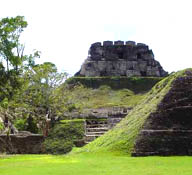Product Description
SEE MORE PRE-COLUMBIAN ARTIFACTS
Unique to the Pre-Columbian Mayans were the iconic stemmed macro blade daggers they flaked out of stone. While many stone tools were similar throughout the world, the stemmed macro blade dagger was totally unique to the Maya, and date back as early as 250 B.C.. These large daggers were flaked entirely from a single, massive core-struck unifacial flake, later worked to have an integral knapped handle, and a long triangular blade with a pointed tip. Average lengths were 6" to 7", up to a typical maximum of 8" long. They were unifacial with large longitudinal facets on a single bulbous side, and a flat underside. The stemmed ends always show secondary flaking on each side, necessary to form the reduced profile of a handle. Most are made of the plentiful chert deposits that are famous in the region, but some were made of obsidian. They were used both, as a handheld weapon, and were also used lashed to wooden poles for stabbing spears. These were weapons of elite warriors and in some cases, were buried in ceremonial caches as offerings to the gods.
With that introduction of the TYPICAL characteristics of stemmed macro blade Mayan daggers, the EXTRAORDINARY nature of this specimen can be better understood. This is the largest known exampleof this unique weapon of the ancient Maya. Flaked with the finest skill of gray and cream chert, it is 16" long (40.6 cm)!!! That is DOUBLE THE LENGTH of the typical MAXIMUM of 8" (20.3 cm)! In addition, while nearly all of these Mayan stemmed macro blade daggers are only with simplistic unifacial flaking, this museum-class example has EXTENSIVE bifacial flaking over ALL surfaces. This has resulted in a level of beauty and workmanship NEVER seen in this type of Mayan weapon. The bifacial flaking on the blade is so exceptional that it has produced a much thinner cross-sectional profile of the entire piece, compared to any other specimen we have seen even half this length! The tip is needle-sharp and the cutting edges show flaking detail never seen. All this incredible workmanship is in the most amazing preserved condition, lacking any damage to any portion or original feature.
Too massive to be of reasonable use, one must ask the question, "Why such an enormous and perfect dagger that far exceeds any other known example, IN EVERY WAY?" We strongly believe this was a personal weapon of an extremely high level ruler. We have NEVER seen any example of this type dagger ever even approach this size, and certainly never with such a degree of bifacial secondary flaking.
A wonderful ancient soil patina adds warmth to the color of the chert. As irrefutable evidence of authenticity and a completely unaltered, original state, all surfaces show original sediment and minerals impacted deep in all the flake scars and micro-crevices of the stone.
HISTORY
 Of all the ancient cultures of the Americas, no civilization has held more intrigue and secrets for so long as that of the Mayans. In 1960, their language code of glyphs was finally deciphered and forever changed our view of what we initially thought was a peaceful and harmonious society. On the contrary, the Mayan Culture of the latter years was bathed in the blood of vicious warfare and astounding levels of human sacrifice. Their technology was so advanced it is no wonder many believe they received intelligence from extra-terrestrials. Despite our recent discoveries of Mayan mathematics, astronomy and calendar technology, the Mayans still leave us with many mysteries. Their love of war caused them to manufacture spectacular weapons with inherent beauty and artistry. Their ceramics depict a fascinating culture of status, sacrifice and deep religious devotion to a number of strange gods.
Of all the ancient cultures of the Americas, no civilization has held more intrigue and secrets for so long as that of the Mayans. In 1960, their language code of glyphs was finally deciphered and forever changed our view of what we initially thought was a peaceful and harmonious society. On the contrary, the Mayan Culture of the latter years was bathed in the blood of vicious warfare and astounding levels of human sacrifice. Their technology was so advanced it is no wonder many believe they received intelligence from extra-terrestrials. Despite our recent discoveries of Mayan mathematics, astronomy and calendar technology, the Mayans still leave us with many mysteries. Their love of war caused them to manufacture spectacular weapons with inherent beauty and artistry. Their ceramics depict a fascinating culture of status, sacrifice and deep religious devotion to a number of strange gods.
Archaeologists divide the Mayan Culture into different periods - LATE PRE-CLASSIC / PROTO-CLASSIC (250 BC - 300 AD), EARLY CLASSIC (300 AD - 600 AD), LATE CLASSIC (600 AD - 830 AD), TERMINAL CLASSIC (830 AD - 900 AD). The earliest days of the Maya date back to 2000 BC when small farming villages first appeared in the highlands and Pacific coastline of Guatemala. Crops such as corn, squash and beans made up the staple of their diet and are believed to have been brought from previous migration through Mexico. The Maya pottery styles were unique to the early Maya settlements, though. By 1000 BC, villages sprang up in the lowland regions. The Maya lived in the same locations for centuries and in a continuous state of architectural improvement and expansion leading up to the magnificent 'super-cities' we associate with them today. By 300 AD. full-scale cities were being built with stone featuring massive plazas, temples and pyramids reaching 20 stories high.
It is no wonder that some believe that extra-terrestrial beings brought their knowledge to the Maya. By 300 AD, the first inscriptions suddenly appeared in Maya sites. These early inscriptions were so beautiful it was as if the gods had delivered it to the Mayan themselves! Forward to 600 years later and the inscriptions cease. The first comprehensive writing system in Pre-Columbian America was invented by the Maya. Among the mysteries of the Maya are their amazing understanding of astronomy along with the development of an accurate calendar and mathematical system. Their number system was based on units of 20 and included a concept of 'zero'.
The skills of the Mayan craft are exemplified in their stone and wood carvings, flaked stone objects, pottery and personal adornment. Much of their art centers around their devotion to a religion that is both fascinating and gory. Blood-letting rituals were the norm and many acts of war were motivated by the capture of vast numbers of their enemies for ritual human sacrifice that would run for days on end, forming lakes of blood and fat at the bases of their stone pyramids that defy architectural explanation.
Our understanding of the fascinating MAYAN CULTURE was completely wrong and misinterpreted until as recent as the 1960, when major achievements were made in the deciphering of their glyph language. Elaborately designed ceremonial cities lacking any obvious defenses initially led us to believe that the Mayans were a peaceful theocracy living in ideal harmony with their environment and each other. We could not have been further from the truth. Lowland city-states lived in constant warfare with one another and the thirst of their gods for human blood and sacrifice seemed impossible to satiate.
Perhaps a lesson for us today, recent scientific analysis of the demise of the highly advanced Mayan civilization now answers the biggest mystery of all - "What ever happened to the ancient Mayans?". Long-term high population density (500 people per square mile - the highest in the world at the time) of unbelievable proportions put a strain on their agricultural system that was impossible to sustain. The effects of nutritional deficiencies are evident in bone and tooth analysis on graves dating to the Late Classic Period. It is most probable that starvation put unbearable sociopolitical stress on the society to either kill each other for food or die of hunger necessitated by the technological advancement of warfare and its escalation.
References:
- Fiedel, Stuart J., Prehistory of the Americas, 1992 - Freeman and Company, Early Man in America, 1973
- Hirth Kenneth, Obsidian Craft Production in Ancient Central Mexico, 2006
- Muser, Curt, Facts and Artifacts of Ancient Middle America, 1978
- Phillips, Charles, The Complete Illustrated History of the Aztec and Maya, 2008
 US DOLLAR
US DOLLAR
 EURO
EURO
 AUSTRALIAN DOLLAR
AUSTRALIAN DOLLAR
 CANADIAN DOLLAR
CANADIAN DOLLAR
 POUND STERLING
POUND STERLING


































